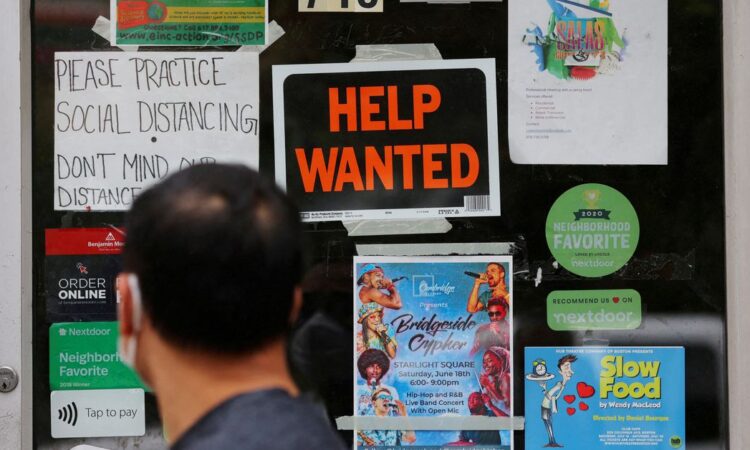
WASHINGTON, Jan 6 (Reuters) – The U.S. economy added jobs at a solid clip in December, pushing the unemployment rate back to a pre-pandemic low of 3.5% as the labor market remains tight, but Federal Reserve officials could draw some solace from a moderation in wage gains.
Still, the U.S. central bank’s fight against inflation is far from being won. The Labor Department’s closely watched employment report on Friday also showed household employment rebounding by a whopping 717,000 jobs last month.
Recent declines in household employment had fanned speculation that nonfarm payrolls, the main measure of employment gains, were overstating job growth.
Labor market resilience, despite the Fed embarking last March on its fastest interest rate-hiking cycle since the 1980s, is underpinning the economy by sustaining consumer spending. It, however, raises the risk the Fed could lift its target interest rate above the 5.1% peak it projected last month and keep it there for a while.
“The labor market remains resilient but is losing pep and worker shortages remain intense,” said Sal Guatieri, a senior economist at BMO Capital Markets in Toronto. “While wage growth has moderated, it’s still far from consistent with price stability. Don’t look for the Fed to ratchet down its hawkish talk or slow the pace of rate hikes on February 1.”
Nonfarm payrolls increased by 223,000 jobs last month, the smallest gain in two years, after rising 256,000 in November. Job growth is more than double the 100,000 that economists say the Fed wants to see to be confident that inflation is cooling. Economists polled by Reuters had forecast payrolls increasing by 200,000 jobs, with estimates ranging from 130,000 to 350,000.
The economy added 4.5 million jobs in 2022, with employment gains averaging 375,000 per month. President Joe Biden welcomed the jobs report, which he described as “a transition to steady and stable growth that I have been talking about for months.”
The strong job gains are despite high-profile layoffs in the technology industry as well as interest rate-sensitive sectors like housing and finance.
Employment gains last month were led by the leisure and hospitality industry, which added 67,000 jobs. Restaurants and bars as well as amusement parks, gambling and recreation places accounted for the bulk of the increase in hiring. Leisure and hospitality payrolls are 932,000 below their pre-pandemic level.
Healthcare industry employment increased by 55,000 jobs. Construction payrolls rose 28,000, despite the housing market collapsing under the weight of higher borrowing costs. Manufacturing employment rose 8,000. There were also gains in transportation and warehousing payrolls as well as retail.
Government employment rose 3,000, though a strike by 36,000 university employees in California hurt state government education payrolls, which fell 24,000.
But cracks are emerging. Professional and business services fell again, with temporary help, a harbinger of future hiring, dropping 35,000. Temporary help jobs have declined by 111,000 since July. The average workweek dipped to 34.3 hours, the shortest since April 2020, from 34.4 hours in November.
Average hourly earnings rose 0.3% after gaining 0.4% in the prior month. That lowered the year-on-year increase in wages to 4.6%, the smallest rise since August 2021, from 4.8% in November.
Stocks on Wall Street rallied on the moderation in wage growth. The dollar fell against a basket of currencies. U.S. Treasury prices rose.
HOUSEHOLD EMPLOYMENT REBOUNDS
Economists said it was premature to believe that wage inflation would cool rapidly. They speculated that wage growth was slowing because the bulk of job cuts were in high-paying technology and finance sectors, while the industries hiring were typically low paying. These industries would need to keep raising wages to attract workers.
The unemployment rate is back at five-decade lows and there were 1.7 jobs for very unemployed worker in November. In addition, 23 states and Washington DC raised the minimum wage on Jan. 1. Most workers across the country will also get cost of living adjustments early in the year.
Other measures, including the Atlanta Fed’s wage growth tracker, show robust gains. Attention now shifts to the fourth-quarter Employment Cost Index data, the broadest measure of labor costs, later this month.
“Wage growth is still about 4.1% higher than December 2021,” said Rhys Williams, chief strategist at Spouting Rock Asset Management in Philadelphia. “While the trend is moving in the right direction, we don’t think the Fed will declare a mission accomplished anytime soon.”
The Fed last year raised its policy rate by 425 basis points from near zero to a 4.25%-4.50% range, the highest since late 2007. Last month, it projected at least an additional 75 basis points of hikes in borrowing costs by the end of 2023.
The drop in the unemployment rate from 3.6% in November reflected robust household employment, where the gains last month more than erased the 323,000 decrease in October and November and offset a 439,000 increase in the labor force in December. The government revised the seasonally adjusted data for the household survey, from which the unemployment rate is derived, for the last five years.
Those revisions reduced the decline in household employment in October and November from the previously reported 466,000 jobs. Some Fed officials have latched onto the divergence between nonfarm payrolls and household employment.
“The idea that household employment was delivering a ‘true’ signal of slowing jobs growth is now unavailable,” said Andrew Hollenhorst, chief economist at Citigroup in New York. “The surge brings it more in-line with stronger payrolls.”
Other details of the household survey were also upbeat. The employment-to-population ratio, viewed as a measure of an economy’s ability to create employment, rose to 60.1% from 59.9% in November. A broader measure of unemployment that includes discouraged workers and those holding part-time jobs for economic reasons fell to 6.5% from 6.7% in November.
“This is still a labor market that continues to test the Fed’s resolve,” said Olu Sonola, head of U.S. regional economics at Fitch Ratings.
Reporting by Lucia Mutikani; Editing by Chizu Nomiyama and Andrea Ricci
Our Standards: The Thomson Reuters Trust Principles.




